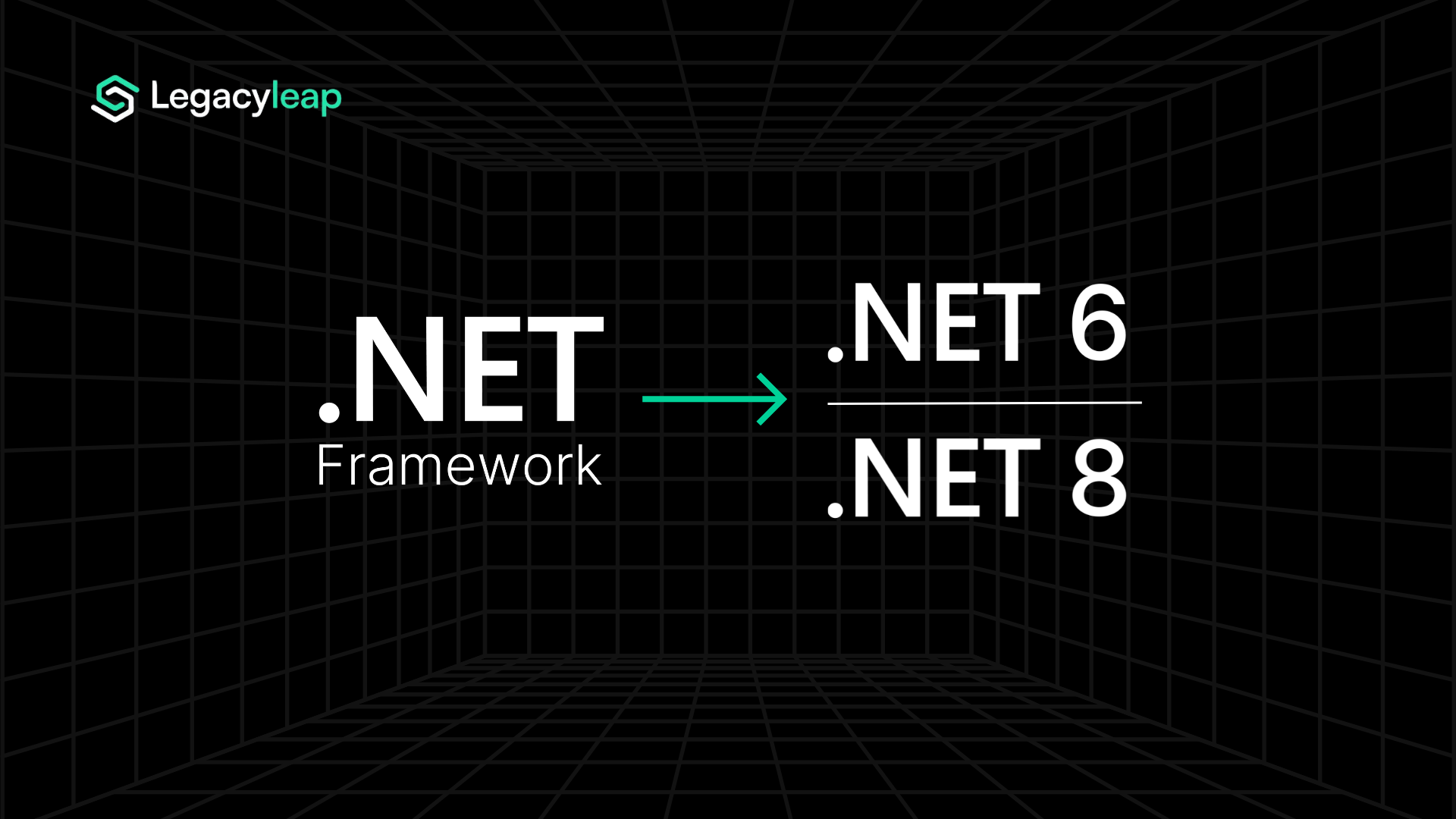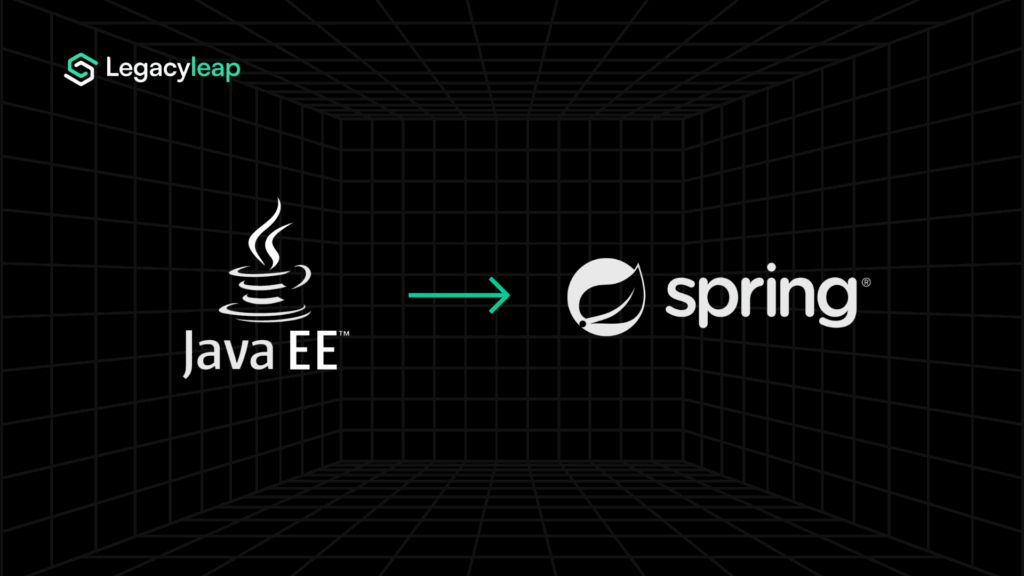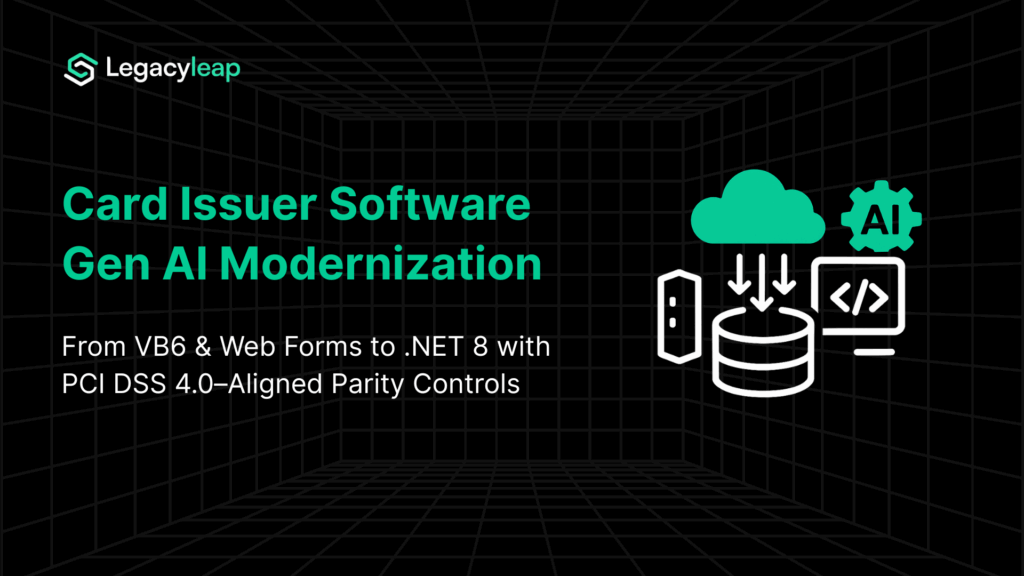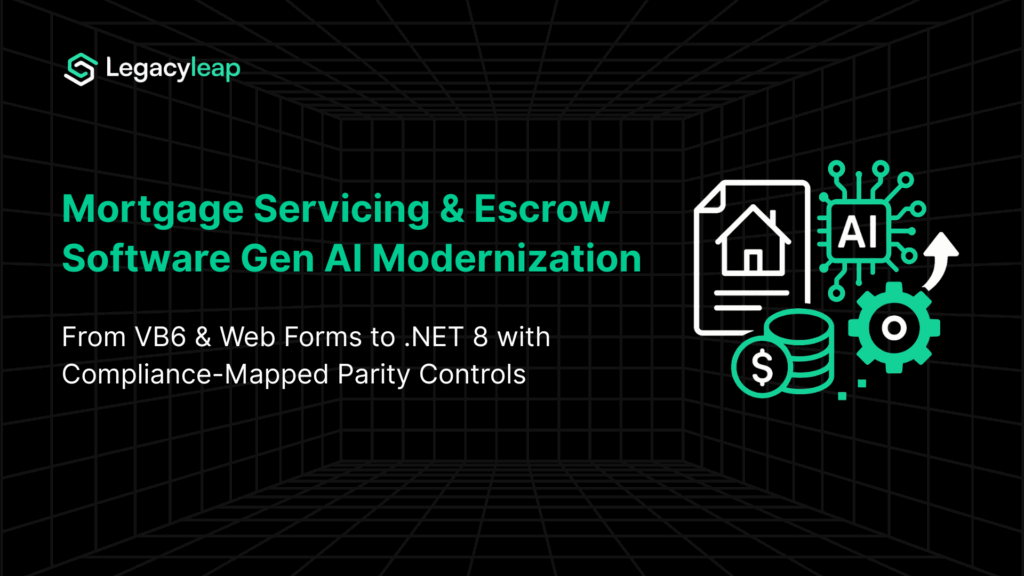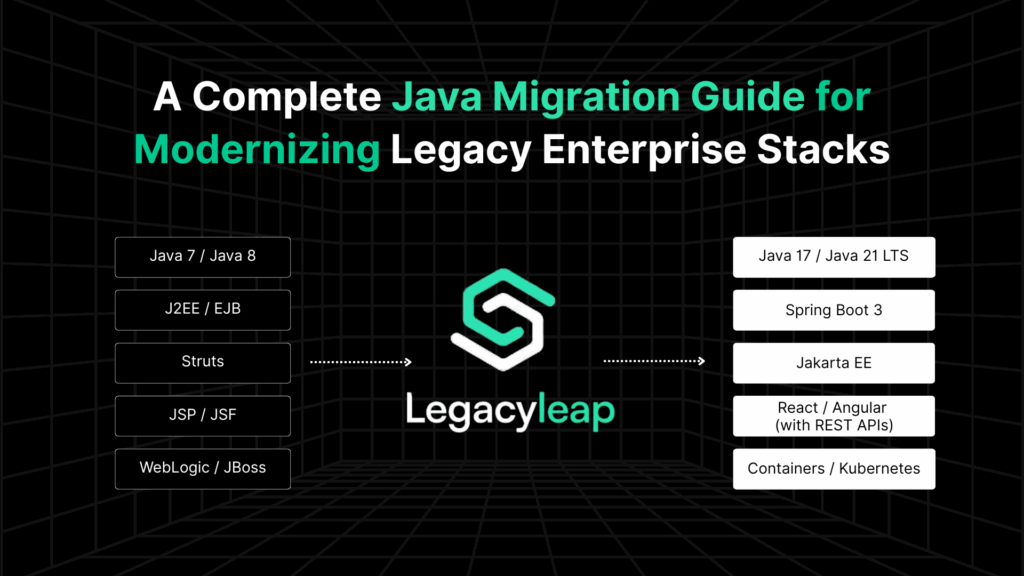Introduction: Why Enterprises Must Move Beyond .NET Framework
.NET Framework is frozen in time. Microsoft retired versions 4.5.2, 4.6, and 4.6.1 in 2022, and even 4.8, the final release, only receives critical security patches (Microsoft Lifecycle). For enterprises in regulated industries like finance, healthcare, and government, this creates a growing compliance and security exposure: no roadmap, no innovation, and rising technical debt.
The modernization timeline is already defined. .NET 6 reached end of support in November 2024, .NET 8 (LTS) is supported through 2026, and .NET 10 will extend long-term support into 2028. The choice isn’t whether to migrate, but how to migrate from .NET Framework to .NET 6 or .NET 8 with predictability and confidence.
This blog addresses that question. We’ll explore the benefits of modern .NET, the common pitfalls enterprises face when migrating, and how Gen AI-driven modernization frameworks now change the risk-reward equation entirely for .NET 6 and .NET 8 migration.
What Are The Advantages of Modern .NET Compared to .NET Framework?
Enterprises that migrate to .NET 6 and .NET 8 gain immediate advantages over Framework-era systems, as it is a shift to a platform that aligns with today’s enterprise priorities:
| Capability | .NET Framework | .NET 6 / .NET 8 |
| Support | Final release (4.8) on critical patches only | Active LTS with ongoing roadmap (.NET 8 → .NET 10) |
| Performance | Legacy runtime, limited optimization | Benchmarked gains in API throughput and memory usage (Microsoft) |
| Cross-platform | Windows-only | Runs on Windows, Linux, macOS |
| Cloud readiness | No native container model | Optimized Docker images, non-root containers, Kubernetes-ready (Microsoft Learn) |
| Security | CAS, remoting, AppDomains, all deprecated | Modern, hardened APIs; better compliance posture |
| Developer experience | Fragmented tooling, legacy project formats | Unified SDK projects, simplified libraries, faster delivery |
For CIOs and CTOs, the value proposition is performance, portability, and security that legacy Framework cannot deliver. Now, the real challenge lies in the execution of bridging the gap from legacy systems to enterprise-ready .NET 6+.
Also read: A Complete .NET Migration Guide for Modernizing Legacy Microsoft Stacks.
Migration Challenges and Strategies in Today’s Landscape
Despite the clear benefits of .NET 6+ migration, enterprises face a consistent set of blockers when moving away from Framework-era systems:
- UI modernization
- WinForms: Supported in .NET 6+, but still Windows-only and unsuitable for cloud-native or cross-platform needs.
- WebForms: Fully deprecated, with no direct migration path. Teams must redesign UI logic for modern frameworks such as Blazor or MAUI.
- WinForms: Supported in .NET 6+, but still Windows-only and unsuitable for cloud-native or cross-platform needs.
- Service migration
- WCF is no longer supported. Enterprises must choose between REST APIs, gRPC, or CoreWCF, each requiring careful re-architecture of service contracts and communication patterns. This often comes up when organizations attempt to convert .NET Framework to .NET 8 at scale.
- WCF is no longer supported. Enterprises must choose between REST APIs, gRPC, or CoreWCF, each requiring careful re-architecture of service contracts and communication patterns. This often comes up when organizations attempt to convert .NET Framework to .NET 8 at scale.
- Data access
- Entity Framework 6 migrations to EF Core often expose feature gaps. While EF Core 8 has near-parity, legacy stored procedure dependencies and custom provider logic remain difficult to port.
- Entity Framework 6 migrations to EF Core often expose feature gaps. While EF Core 8 has near-parity, legacy stored procedure dependencies and custom provider logic remain difficult to port.
- Deprecated APIs
- Core Framework constructs like System.Web, CAS, AppDomains, and System.Drawing do not translate to cross-platform .NET 6+, creating runtime and hosting breaks in Linux and containerized environments.
- Core Framework constructs like System.Web, CAS, AppDomains, and System.Drawing do not translate to cross-platform .NET 6+, creating runtime and hosting breaks in Linux and containerized environments.
- Available tools
- Microsoft’s Upgrade Assistant, Portability Analyzer, and AWS’s Porting Assistant accelerate assessments, but they provide only partial automation. Enterprises still need significant manual effort to resolve incompatibilities and validate functional parity.
- Microsoft’s Upgrade Assistant, Portability Analyzer, and AWS’s Porting Assistant accelerate assessments, but they provide only partial automation. Enterprises still need significant manual effort to resolve incompatibilities and validate functional parity.
- Architectural strategies
- Patterns like Strangler Fig and Anti-Corruption Layer allow phased migration, but they introduce integration overhead and rarely guarantee functional parity across large, business-critical systems.
- Patterns like Strangler Fig and Anti-Corruption Layer allow phased migration, but they introduce integration overhead and rarely guarantee functional parity across large, business-critical systems.
This results in migration projects that are typically slower, costlier, and riskier than stakeholders anticipate. Even with tools and patterns, CIOs and CTOs are left with uncertainty about cost, scope, and delivery timelines.
Why Gen AI Changes the Migration Playbook
Traditional migration approaches leave too much to chance. Tools accelerate pieces of the journey, but they don’t guarantee outcomes at enterprise scale. Gen AI, when applied with compiler-grade guardrails, changes the operating model:
- Complete comprehension before cutover
- Graph-based analysis maps every dependency across UI, services, and data layers before any transformation begins.
- Graph-based analysis maps every dependency across UI, services, and data layers before any transformation begins.
- Automated translation of legacy constructs
- WCF → REST/gRPC, WebForms → Blazor, EF6 → EF Core mappings are applied systematically, not piecemeal. For enterprises planning to upgrade .NET Framework to .NET 8, this means consistency across services and layers.
- WCF → REST/gRPC, WebForms → Blazor, EF6 → EF Core mappings are applied systematically, not piecemeal. For enterprises planning to upgrade .NET Framework to .NET 8, this means consistency across services and layers.
- Compiler validation + human oversight
- Every AI-driven transformation is verified structurally, auditable against enterprise coding standards, and refined by SMEs at key checkpoints.
- Every AI-driven transformation is verified structurally, auditable against enterprise coding standards, and refined by SMEs at key checkpoints.
- Functional parity assurance
- Auto-generated unit, API, and regression tests validate that the modernized application behaves exactly like its legacy counterpart.
- Auto-generated unit, API, and regression tests validate that the modernized application behaves exactly like its legacy counterpart.
The impact is measurable:
- Up to 70% automation in code transformation.
- 40–50% faster development cycles compared to manual methods.
- 60–80% less manual effort during comprehension and refactoring.
This is not AI as an assistant, but as a modernization framework. By flipping uncertainty into predictability, enterprises can treat .NET migration as a managed process with clear timelines, lower costs, and validated outcomes.
Also read: How Can Gen AI Drive Every Step of Your Modernization Journey?
Legacyleap in Action: Verified Modernization Outcomes
Migrating from .NET Framework to .NET 6+ comes with its own set of organizational challenges: lack of documentation, loss of tribal knowledge, fragile dependencies, and the risk of breaking business-critical systems during cutover. This is why traditional tools and patterns stall when applied at enterprise scale.
Legacyleap was purpose-built to address those exact gaps because it’s not another migration script. It’s a purpose-built platform engineered to make modernization predictable, verifiable, and enterprise-ready.
- Comprehension beyond surface scans:
- Instead of partial code analyzers, Legacyleap parses applications into abstract syntax trees (ASTs), converts them into MLIR (multi-level intermediate representation), and maps them in a graph database. This provides a system-wide model of dependencies across UI, services, and data layers, before a single line is refactored..
- Instead of partial code analyzers, Legacyleap parses applications into abstract syntax trees (ASTs), converts them into MLIR (multi-level intermediate representation), and maps them in a graph database. This provides a system-wide model of dependencies across UI, services, and data layers, before a single line is refactored..
- Enterprise-grade architecture:
- The platform was designed for scale: millions of lines of code, multiple stacks, and interconnected upstream/downstream systems. Unlike local developer tools, Legacyleap runs entirely within the enterprise environment, with zero external API calls, a critical requirement for regulated industries.
- The platform was designed for scale: millions of lines of code, multiple stacks, and interconnected upstream/downstream systems. Unlike local developer tools, Legacyleap runs entirely within the enterprise environment, with zero external API calls, a critical requirement for regulated industries.
- Human-in-the-loop by design:
- Gen AI outputs are never applied blindly. Compiler guardrails constrain code generation, and every step has explicit checkpoints for engineers to review, approve, or refine. This balances automation with control, a requirement for systems that can’t afford regression.
- Gen AI outputs are never applied blindly. Compiler guardrails constrain code generation, and every step has explicit checkpoints for engineers to review, approve, or refine. This balances automation with control, a requirement for systems that can’t afford regression.
- End-to-end modernization workflow:
- Beyond code conversion, the platform auto-generates safety nets (unit/API/regression tests), documentation layers (business logic summaries, Swagger specs, architectural maps), and deployment artifacts (Helm charts, Terraform, Dockerfiles). This ensures modernization doesn’t stop at “code compiles”, but carries through to deployment and functional parity validation.
- Beyond code conversion, the platform auto-generates safety nets (unit/API/regression tests), documentation layers (business logic summaries, Swagger specs, architectural maps), and deployment artifacts (Helm charts, Terraform, Dockerfiles). This ensures modernization doesn’t stop at “code compiles”, but carries through to deployment and functional parity validation.
- Predictability for decision-makers:
- The biggest advantage is clarity and certainty. CIOs and CTOs see accurate scoping, dependency maps, and feasibility insights upfront. Instead of hoping a migration “works out,” leaders know cost, risk, and timelines with clarity before a single production rollout.
In practice, this means:
- 100% system coverage in dependency mapping before refactoring starts — eliminating hidden blockers.
- 90%+ automated test coverage (unit, API, regression) generated directly from legacy behavior to guarantee functional parity.
- Zero external API calls: All processing runs inside the enterprise environment, ensuring security and compliance.
- 100% functional parity validated before cutover, with discrepancies surfaced through auto-generated test suites.
With this foundation, enterprises don’t treat .NET Framework → .NET 6+ migration as a gamble. They execute it as a managed, verifiable program, faster, safer, and aligned with business-critical outcomes.
Also read: Why Legacyleap Is Your AI Companion Platform for Enterprise-Scale Modernization.
Conclusion: A Verified Path to .NET 6+
Remaining on .NET Framework is no longer sustainable. With most versions retired and 4.8 frozen on security patches, every year of delay compounds compliance, security, and technical debt risk.
The payoff for moving to .NET 6 and .NET 8 is clear: higher performance, cross-platform flexibility, and cloud-native readiness. The problem is that conventional migration tools and patterns leave too many gaps with hidden dependencies, uncertain rewrites, and no guarantee of functional parity.
Legacyleap changes that equation. By combining Gen AI automation with compiler-grade validation and human oversight, it provides a safer, faster, and verifiable modernization path for enterprise .NET systems.
Start with a $0 Assessment and see your actual modernization plan, dependency maps, risk scans, and feasibility insights delivered upfront, with no cost and no risk.
FAQs
Q1. Why can’t enterprises stay on .NET Framework?
Microsoft has frozen .NET Framework at 4.8 with only security patches. Earlier versions like 4.5.2 and 4.6 are already retired, which leaves enterprises exposed to compliance and security gaps.
Q2. What’s the business payoff of moving to .NET 6/8?
Modern .NET delivers faster runtime performance, cross-platform support, cloud-native deployment, and long-term Microsoft lifecycle coverage that Framework no longer provides.
Q3. How does Gen AI accelerate migration from Framework to .NET 6+?
Legacyleap Gen AI automates dependency mapping, refactoring, and parity testing. Compiler-grade guardrails ensure migrated applications behave exactly as intended.
Q4. Does modernization disrupt live business applications?
No. Legacyleap supports phased rollouts and parallel testing. Regression suites validate parity before cutover, reducing downtime and risk during transition.
Q5. How long does migration typically take with Legacyleap?
What once took 6-12 months of manual effort can usually be completed in 2-4 months with Gen AI automation, safety nets, and enterprise-ready governance.


